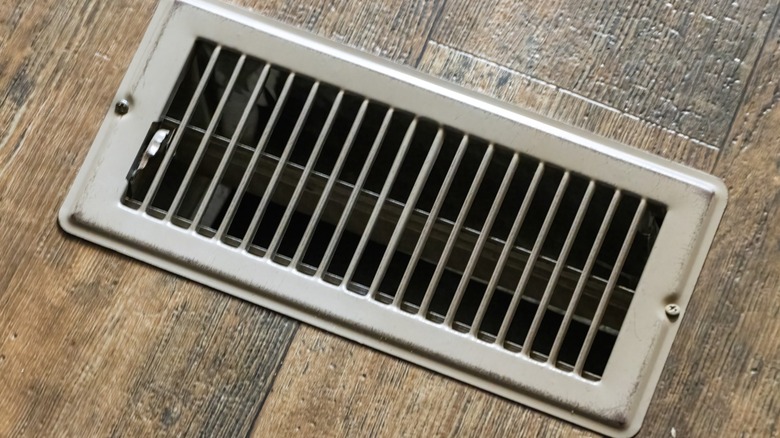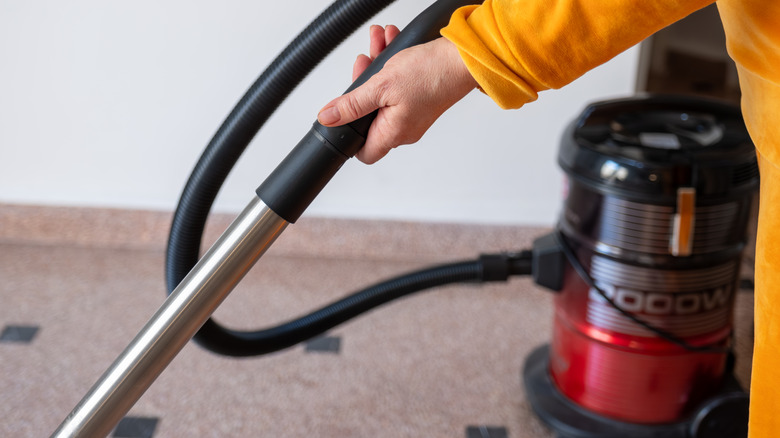Is This Closet Staple The Solution To Dirty Floor Vents?
We may receive a commission on purchases made from links.
Floor vents are an energy-efficient and relatively easy-to-maintain choice for many home builders. You will find them in homes in cooler climates more often than ceiling vents because warm air rises, making them ideal for heating homes in the winter months. Unfortunately, like anything else on a floor, they tend to collect dust, pet hair, and other debris, especially in rooms with a lot of foot traffic. Over time, the debris that falls into your floor vents can cause efficiency issues with your home's heating system and even end up damaging it, which could cost you a pretty penny. Fortunately, though, there are ways to keep debris from falling into your home's floor vents.
In a viral TikTok video, a creator showed the significant amount of hair and debris that had fallen into her vent. Then, she slid pantyhose over it before screwing it back into the floor. After the pantyhose were applied, she demonstrated how effective the hack was at keeping dirt and fragments from getting in. As it turns out, it really works.
To make a pantyhose screen to cover your floor vents, remove the vent cover using a screw driver. Then, cut a length of pantyhose and slide the vent inside. Finally, replace the vent cover and drive the screws back in to secure it. This super-simple hack keep debris and small items out of your floor vents. It's not without its issues, though.
Do pantyhose allow enough airflow to be used on floor vents?
This hack works much the same way as the hack that uses pantyhose to find missing objects. But while some commenters remarked how smart it was, others expressed concerns about how the stockings might affect the vent's airflow. Fortunately, since pantyhose have been used for desktop computer fan filters for years, there's some amateur research available on whether they significantly restrict airflow. In 2024, Hands On Katie, a YouTube creator, recorded a thorough experiment on this topic. What she found was that low-denier pantyhose (denier is the number on a pantyhose package that indicates the thickness of the yarn used) that were fitted tightly around the fan did have an impact on airflow, but it wasn't nearly as significant as some people claimed. Unfortunately, since this isn't a common floor vent hack, opinions from HVAC experts are lacking.
That said, if you're having an issue with floor vent debris that's major enough for you to consider covering the vent with pantyhose, it's possible the debris may actually be blocking more airflow than a pair of tights ever could. To be on the safe side, it's a good idea to prevent dirt and debris from getting into your floor vents to begin with and to clean them regularly. There are products that can help keep things from falling into your vents, as well.
How to keep debris and pet hair out of your floor vents
A simple way to prevent debris from falling into your floor vents is to replace your current vents with registers that close, such as the heavy-duty louvered floor vents from Handua on Amazon. When your vents aren't in use, which for some people is several months out of the year, you can close them so nothing can fall into the ducts. Of course, while the vents are in use, there would be no protection for the ducts using this method. Amazon also sells floor register screen traps, a widely used solution to the debris-collection issue. These net traps secure to the underside of your floor vents and are designed to catch objects that fall through the vent's slats without restricting air flow.
There's also a way to prevent dirt and other things from falling into your home's ducts without changing your vent cover or adding anything to it. Keeping your floors clean so there's less debris available to fall into your ducts can help ensure you don't need to make changes to the vents. It can also reduce how often you clean your floor vents. But if you don't already, you should still add vent cleaning to your regular floor maintenance. When you clean your floors, remove the registers and use a thin vacuum attachment to reach into your vents and suck out any debris.

